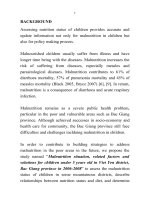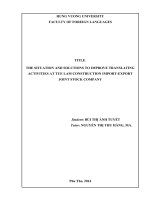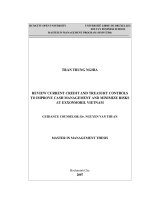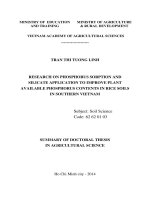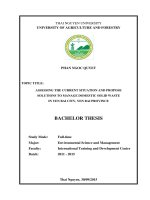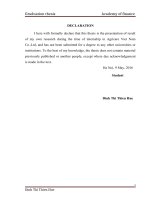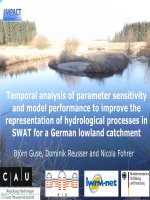Assessing current state and proposing solutions to improve waste water treatment effectively in ha bac export garment joint stock company
Bạn đang xem bản rút gọn của tài liệu. Xem và tải ngay bản đầy đủ của tài liệu tại đây (1.57 MB, 83 trang )
MINISTRY OF AGRICULTURE AND RURAL DEVELOPMENT
VIETNAM FORESTRY UNIVERSITY
STUDENT THESIS
ASSESSING CURRENT STATE AND PROPOSING SOLUTIONS TO
IMPROVE WASTE WATER TREATMENT EFFECTIVELY IN HA BAC
EXPORT GARMENT JOINT STOCK COMPANY
Major: Natural Resources Management
Code: D850101
Faculty: Forest Resources and Environmental Management
Student: NGUYEN CONG DAI
Class: K59B Natural Resources Management
Student ID: 1453091084
Course: 2014 - 2018
Advanced Education Program
Developed in collaboration with Colorado State University, USA
Supervisor: Assoc. Prof. Tran Quang Bao, Ph.D.
Hanoi, 2018
ACKNOWLEDGEMENT
During 2 months conducted this study, I received lots of help and encouragement from
many people without whom this study would have never happened
First and foremost, I would like to express my sincere gratitude to my advisor Dr. Tran Quang
Bao for the continuous support of my student thesis study and research, for his motivation,
enthusiasm, and immense knowledge. His guidance helped me in all the time of research and
writing of this thesis. Beside my advisor, I would like to thank the administration of Vietnam
Forestry University, Faculty of Forest Resources and Environmental Management, Center for
Environmental Analysis and Application of Geospatial Technology with enthusiasm to impart
valuable knowledge for us. Next, I also would like to thank Mrs. Nguyen Thi Ngoc Bich and
teachers who helped me analyze waste water samples to complete student thesis worked at
building T7 in Vietnam Forestry University.
My sincere thanks also goes to many people for their contribution to this research; Mr.
Dang Van Long- Director of Ha Bac Industrial Washing Joint Stock Company; the Staves in
Ha Bac Industrial Washing Joint Stock Company who provided me many useful knowledge
about washing process, wastewater treatment process and create some great opportunities for
me visit to operation areas of these processes. I also would like to thank Ha Bac Export
Garment Joint Stock Company.
Finally, I would further like to thank my family: my parents who always support to me
and my friends who helped me in my research.
Hanoi, 30 September 2018
Nguyen Cong Dai
2
ABSTRACT
1. Topic of student thesis: “Assessing Current State And Proposing Solutions To Improve
Waste Water Treatment Effectively In Ha Bac Export Garment Joint Stock Company”
2. Student: Nguyen Cong Dai
Student ID: 1453091084
3. Supervisor: Assoc. Prof. Tran Quang Bao, Ph.D.
4. Objectives:
Evaluating the quality of wastewater in Ha Bac Export Garment Joint Stock Company
Suggesting solutions for improving wastewater quality in the company
5. Research contents:
The production process of the plant, the nature of the waste water source (inputs, outputs,
production processes, discharge stages ...)
Evaluate the efficiency of the waste treatment and the environmental management system of
the plant
6. Results:
Ha bac export garment joint stock company is one of the 50 largest garment enterprises
in Vietnam. Now, the company includes 3 factories (2 garment factories and 1 industrial
washing factory) and manufacture over 13 million products/ year. The company also has the
necessary investment for environmental protection but the efficiency is not high.
Identify sources of waste (solid waste, waste gas, waste water) of the company and their
impact on the environment. Analysis of the sampling results from the site shows that the
wastewater of the company is within the permitted level of QCVN 40: 2011 / BTNMT.
However, there are some indicators that exceed the allowed QCVN are organic substances
containing parameters: TSS, turbidity.
The Environmental Quality Control Department is responsible for planning the
environmental protection of the company and for controlling the quality and quantity of the
company's wastewater before it is released into the environment.
The company is interested in waste treatment and has invested in equipment and
machinery in the production process, waste water treatment process but compared to the
present, the production and processing technology is quite old should not be as high as
desired. Therefore, the company should upgrade and update the advanced production and
processing technology in the world to achieve high economic efficiency while saving energy
and protecting the environment.
3
LIST OF TABLES
Table 2.1: Parameters: pre-treatment wastewater quality…………………………………….17
Table 3.1: Sampling locations………………………………………………………………...24
Table 5.1: The main waste water source in company………………………………………...40
Table 5.2: Data form of the results of analyzing necessary indicators in wastewater from Ha
Bac Export Garment Joint Stock Company…………………………………………………..50
Table 5.3: Results of waste water analysis from washing process of Ha Bac industrial washing
Joint Stock Company…………………………………………………………………………51
4
LIST OF FIGURES
Figure 2.1: The diagram of process technology MBRR wastewater treatment………………12
Figure 2.2: Aerobic tank ……………………………………………………………………..14
Figure 2.3: Anaerobic tank……………………………………………………………………14
Figure 2.4: The diagram of the processing technology for water treatment in textile and
garment industry……………………………………………………………………………...19
Figure 3.1: Wastewater collection tank………………………………………………………24
Figure 3.2: Sediment tank…………………………………………………………………….24
Figure 3.3: Sampling diagram in Ha Bac Industrial Washing Joint Stock Company………...25
Figure 3.4: Some photos visiting the workspace in the company…………………………….26
Figure 4.1: Geographic location map of Ha Bac export garment joint stock company………31
Figure 4.2: Ha bac export garment joint stock company organization chart…………………34
Figure 4.3: Organization chart of washing factory…………………………………………...35
Figure 4.4: Organization chart of factory 1…………………………………………………...35
Figure 4.5: Organization chart of factory 2…………………………………………………...36
Figure 4 .6: Rate of products in company…………………………………………………….37
Figure 4.7: Kind of products and the markets of company…………………………………...37
Figure 5.1: Diagram of production technology in factory……………………………………39
Figure 5.2: The drainage plan for rainfall chart………………………………………………41
Figure 5.3: The amount of water for daily activities chart……………………………………42
Figure 5.4: The amount of water for production chart………………………………………..42
Figure 5.5: Diagram of drainage system, canal, ditch after treatment to receiving source…...44
Figure 5.6: Operation diagram of wastewater treatment system……………………………...45
Figure 5.7: Diagram of areas in sedimentation tank………………………………………….46
Figure 5.8: Diagram of decomposition of surfactant and colorant separated from flotation
device…………………………………………………………………………………………48
Figure 5.9: Diagram of floatation tower……………………………………………………...49
Figure 5.10: Temperature value of wastewater from Ha Bac industrial washing Joint Stock
Company………………………………………………………………………………….…..53
Figure 5.11: pH value of wastewater from Ha Bac industrial washing Joint Stock
Company……………………………………………………………………………………...53
Figure 5.12: TSS value of wastewater from Ha Bac industrial washing Joint Stock
Company……………………………………………………………………………………...54
Figure 5.13: COD value of wastewater from Ha Bac industrial washing Joint Stock
Company……………………………………………………………………………………..55
5
Figure 5.14:
N-NH4+ value of wastewater from Ha Bac industrial washing Joint Stock
Company……………………………………………………………………………………...56
Figure 5.15:
P-PO43- value of wastewater from Ha Bac industrial washing Joint Stock
Company……………………………………………………………………………………...56
Figure 5.16:
Cl- value of wastewater from Ha Bac industrial washing Joint Stock
Company……………………………………………………………………………………...57
Figure 5.17: pH value of treated wastewater from Ha Bac industrial washing Joint Stock
Company…………………………………………………………………………….………..57
Figure 5.18: COD value of treated wastewater from Ha Bac industrial washing Joint Stock
Company…………………………………………………………………………….………..58
Figure 5.19: DO value of treated wastewater from Ha Bac industrial washing Joint Stock
Company……………………………………………………………………………………...59
Figure 5.20: TSS value of treated wastewater from Ha Bac industrial washing Joint Stock
Company……………………………………………………………………………….……..59
Figure 5.21: N-NH4+ value of treated wastewater from Ha Bac industrial washing Joint Stock
Company………………………………………….…………………………………………..60
Figure 5.22: P-PO43- value of treated wastewater from Ha Bac industrial washing Joint Stock
Company……………………………………….……………………………………………..61
Figure 5.23: Cl- value of treated wastewater from Ha Bac industrial washing Joint Stock
Company……………………………………………………………………………………...61
6
ACKNOWLEDGEMENT……………………………………………………………………2
ABSTRACT…………………………………………………………………………………...3
LIST OF TABLES……………………………………………………………………………4
LIST OF FIGURES…………………………………………………………………………..5
TABLE OF CONTENTS…………………………………………………………………….7
CHAPTER I. INTRODUCTION……………………………………………………………9
CHAPTER II. LITERATURE REVIEW………………………………………………….10
2.1. The generality of garment manufacture in the world………………………………..10
2.1.1. The history of the formation and development of the textile and garment industry in the
world………………………………………………………………………………………….10
2.1.2. The characters of the textile industry in the world……………………………………..10
2.1.3. The waste water treatment advanced technology in garment manufacture……………12
2.2. The generality of garment manufacture in Vietnam…………………………………14
2.2.1. The history of the formation and development of the textile and garment industry in
Vietnam……………………………………………………………………………………….14
2.2.2. The origin and characters of waste water source in garment manufacture factory…….15
2.2.3. The effects of waste water source in garment manufacture factory on environment….18
2.2.4. The generality of waste water treatment technology in garment manufacture………...18
CHAPTER III. OBJECTIVES AND METHODOLOGY:……………………………….24
3.1. Goal & Specific objectives……...………………………………………………………24
3.2. Sampling area & Time………………………………………………………………….24
3.3. Study methods.………………………………………………………………………….26
3.3.1. Secondary data collection………………………………………………………….26
3.3.2. Method of investigation………………………………………………………………..26
3.3.3. Analytical method in the laboratory…………………………………………………....27
3.3.4. Data processing method………………………………………………………….…….30
CHAPTER IV. INTRODUCTION ABOUT NATURAL – SOCIAL AND ECONOMIC
CONDITIONS OF STUDY AREA AND HA BAC EXPORT GARMENT JOINT
STOCK COMPANY………………………………………………………………….……..31
4.1. Natural conditions.……………………………………………………………………..31
4.1.1. Geographical location and Topography………………………………………………..31
4.1.2. Climate ………………………………………………………………………………...31
4.2. Social and economic conditions………………………………………………………..33
4.3. General introduction about the company…………………………………………….34
4.3.1. The established history………………………………………………………………...34
7
4.3.2. The main business activities of the company………..…………………………………36
4.3.3. The oriented development……………………………………………………………...36
4.3.4. The main product lines of the company………………………………………………..36
4.3.5. The potential and prospects of the company…………………………………………...38
CHAPTER V. RESULTS AND DISSCUSSION…………………………………………..39
5.1. The production situation and discharging source in Ha Bac Export Garment Joint
Stock Company………………………………………………………………………….…..39
5.1.1. The production situation and garment manufacturing process………………………...39
5.1.2. The main waste water source and the characters of waste water source in company….40
5.2. The Current state of the waste water quality in Ha Bac Export Garment Joint Stock
Company…………………………………………………………………….……………….41
5.2.1. The waste water collection and waste water treatment technology……………………41
5.2.2. The drainage system into the waste water receiving source…………………………...44
5.3. The results of waste water analysis and the efficiency of wastewater treatment
system in Ha Bac Export Garment Joint Stock Company……………………………….49
5.3.1. Study the quality of wastewater through the treatment stages………………………...49
5.3.2. Results of analyzing waste water samples…………………………………………….50
5.3.3. Current situation in wastewater treatment of Ha Bac industrial washing Joint Stock
Company……………………………………………………………………………………...62
5.4. Suggesting solutions to improve the quality of wastewater for Ha Bac Export
Garment Joint Stock Company…………………………………………………………….63
5.4.1. The technological solutions …………………………………………………………...63
5.4.2. The solutions in management …………………………………………………………64
CHAPTER VI. CONCLUSION - LIMITATIONS – RECOMMENDATIONS………..65
6.1. Conclusion……………………………………………………………………………….65
6.2. Limitations……………………………………………………………………………….65
6.3. Recommendations………………………………………………………………………..65
REFERENCES ………………………………………………………………………….…..67
APPENDIX…………………………………………………………………………………..68
8
CHAPTER I. INTRODUCTION
In recent years, the textile and garment industry has been developing strongly and
increasingly serving customers' demand. However, the downside is that it generates large
amounts of waste, including solid waste, gas and sewage, and these are also major causes of
global environmental pollution.
The textile and garment industry is one of the most important industries and has made a
significant contribution to the improvement of people's living and income and employment.
Ha bac export garment joint stock company is one of the 50 largest garment enterprises in
Vietnam. The company was established in September 2002, with over 3,000 experienced and
skillful staffs, with advanced equipment and advanced equipment. The company has a total
area of 40,000 square meters. The company specializes in manufacturing garment products
including make products according to samples available from customer's orders and Launder
or dye the products according to samples available from customers' orders. The company has
played an important role in the development of neighboring areas as well as Bac Giang
province. The production activities of the plants are constantly developing the product
volume, which makes the quality of waste increased constantly. In particular, by looking at
the sources, I found no one to do research to assess the quality of wastewater at the Ha Bac
Garment Export Joint Stock Company. Therefore, in front of the real situation of the company
I have started to implement the topic: “Assessing Current State And Proposing Solutions To
Improve Waste Water Treatment Effectively In Ha Bac Export Garment Joint Stock
Company”. Thereby, I want to know how the company has environmental management
policies. How effective are these policies applied? What are the existing environmental
management issues of the company today?
The result of the research is to make objective assessment comments together with
solutions to improve the environmental protection for the plant. This will contribute to the
company's sustainable development and environmental friendliness.
9
CHAPTER II. LITERATURE REVIEW
2.1. THE GENERALITY OF GARMENT MANUFACTURE IN THE WORLD
2.1.1. The history of the formation and development of the textile and garment industry
in the world.
The history of textile and apparel development is also the history of shifting the textile and
apparel industry from the developed to the less developed area by the effects of comparative
advantages. However, this does not mean that the textile industry no longer exists in
developed countries but it has grown higher with high fashion products to cater to a group of
people.
This change began in 1840 from England to other European countries. It was followed by
Europe from Japan in the 1950s. Since 1960, when the cost of manufacturing in Japan
increased and the labor force was lacking, the textile industry moved to new industrialized
countries (NICs). Hong Kong, Taiwan, Korea. Due to the shift of the textile industry, by
1980, the comparative advantage of the textile industry was declining. These countries shifted
to producing high-tech and technical products such as automobiles and electronics. he textile
industry continues to shift to South Asian countries, China and then to other countries,
including Vietnam.
2.1.2.The characters of the textile industry in the world
a) On consumption:
In the world trade, textile and garment products are one of the first commodities to enter
into international trade, and textiles and clothing have particular characteristics that greatly
affect production and trade. Some of these features are:
Textiles and garments have a rich and varied demand depending on consumers different consumers in terms of culture, geographical area, climate, sex, age, etc.
different in costumes. Market research to understand the demand of each group of
people in different markets is especially important in the consumption of products.
High-fashion textiles and garments must change their designs, styles, colors and
materials in order to meet the needs of new, unique and impressive consumers.
Therefore, to understand the trends of fashion is very important.
Labeling is also one of the prominent features of the world's textile and clothing trade.
Each manufacturer needs to create its own brand. Product branding from a social point
of view is often a factor in certifying the quality of goods and the reputation of
producers, which is a matter of concern in the product strategy because consumers not
only take into account prices but also the quality of the product.
10
In the trade of textile products, attention should be paid to seasonal factors. Must be
based on the cycle of weather change in the year in each area, the school that supplies
goods accordingly. This is also related to delivery deadlines.
Consumption habits are also a feature that should be noted in the textile and clothing
trade as it directly affects the market for the product.
b) On manufacture:
The textile industry is a labor-intensive industry, with initial capital not too large but with
high interest rates. Thus, textiles and clothing production often develops and is very effective
for developing countries and is in the early stages of industrialization, when a country
becomes a developed industrialized country. High technology, competitiveness in textile
production decreased, they reached other industries with high technical content, labor cost and
profitable. The textile industry is promoting its role in less developed countries. The history of
the textile and apparel industry in the world is also a history of shifting the textile industry
from the developed to less developed regions by shifting the comparative advantage. It does
not mean that textile production no longer exists in industrialized countries but in fact the
sector goes to the higher stage, producing high added value products. In recent years,
Vietnam's textile and garment production has made some progress and is trying to integrate
itself into the world textile and apparel industry.
The impacts of trade liberalization on the textile and apparel industry in the world
The characters of the textile and garment market in the present period are evident in
globalization and integration, which is the most common feature in the development of global
commercialization. The use of tariff barriers and protectionism will become obsolete and
trade borders will be gradually eradicated. In the future, deciding where to place the
production will be low labor cost and where the raw material supply meets the needs of
customers. So any country that wants to grow must enter the world market by its own
advantage with the efficient exploitation of advanced technologies in the world. Integration
does not mean creating the same development and resources for all nations in the world but
creating an equal environment for member states to maximize their capabilities. the
development of textiles, so the development in each country will be different. For developed
countries such as EU, US, Japan, ... will focus on high quality goods. At the same time, these
countries will also transfer technology to countries with lower technology production. For
developing countries, technological innovation is a vital requirement for improving
production capacity, creating good quality products that meet the needs of the market.
However, due to the low level of technology, the advantage of these countries is the low cost
of labor and the development of textiles and clothing is also significant in solving
11
employment problems for workers in countries. Population such as China, Vietnam,
Indonesia, ... So in the future developing countries continue to produce processing for export
is to take advantage of cheap labor. In addition, these countries will also invest in a number of
high-quality, competitive-priced items to boost returns from exports.
2.1.3. The waste water treatment advanced technology in garment manufacture
MBBR (Moving bed bioreactor) technology is an activated sludge technology that
applies microbiological sticking technique on moving material bed. Due to the use of
microbial material, the microbial density (MLVSS) in the treatment tank is higher than that of
the dispersed activated sludge technique.
Process technology MBRR wastewater treatment:
circulation
Air
Air
Air
Air
Wastewater
Treated
wastewater
Air conditional
tank
Denitrification
BOD/COD
Nitrification
Sludge circulation
O2 Depletion
Sediment tank
Treated
wastewater tank
Sludge
Figure 2.1: The diagram of process technology MBRR wastewater treatment
12
The material that makes the substrate lighter in weight than the water ensures the
suspended condition. The substrate is constantly moving throughout the tank volume thanks
to the air blower and the stirrer through which the micro-density increases and the processing
efficiency is higher.
In the MBBR aerobic tank, the gas supply system is provided to facilitate the growth
and development of aerobic microorganisms. At the same time, the gas supply process must
ensure that the material is always in suspended state and continuously stirred during the
reaction. Microorganisms capable of decomposing organic compounds will adhere to and
grow on the surface of the material. Aerobic microorganisms convert organic matter into
waste water to grow into biomass. The microbial discharges will grow and thicken very
rapidly along with the depletion of organic matter in the wastewater. When reaching a certain
thickness, the microbial masses will increase, the microorganisms inside, due to lack of
contact with the food source, will die, the ability to cling to the material no longer. When they
do not stick to the surface of the material will fall off into the waste water. Small amounts of
microorganisms on the material will continue to use organic compounds in the wastewater to
form a new organism.
Apart from the task of treating organic compounds in waste water, the suspended
aerobic bacteria are also involved in nitrification and denitrification, which removes nitrogen
and phosphorus compounds in wastewater. no need to use anoxic tank. Microorganisms on
the surface of the filter material consists of three types: the outer layer is aerobic
microorganism, followed by the microorganism gas, the inner layer is anaerobic
microorganisms. In domestic wastewater, nitrogen is predominantly in the form of ammonia,
an organic nitrogen compound. Aerobic organisms convert nitrate to nitrite, nitrate.
Continuous aerobic and anaerobic microorganisms will use organic compounds in wastewater
as oxidants to remove nitrate and nitrite to the N2 form of fly ash. On the other hand, part of
the nitrogen process is carried out in the biological sedimentation tank. Therefore, the
efficiency of treatment of nitrogen and phosphorus compounds in wastewater of this project is
very good.
Integrated MBBR floating bed system consists of two types: aerobic and anaerobic
tanks. In the aerobic tank, the movement of the substrate was made possible by the diffusion
of medium sized air bubbles from the air blower. In an anaerobic tank, this process is created
by mixing the substrate with the agitator.
13
Figure 2.2: Aerobic tank
Figure 2.3: Anaerobic tank
2.2. THE GENERALITY OF GARMENT MANUFACTURE IN VIETNAM
2.2.1. The history of the formation and development of the textile and garment industry
in Vietnam.
Traditional textile and garment operations in Vietnam have existed for a long time.
Some traditional villages still exist and developed such as Van Phuc (Ha Dong - Hanoi), Trieu
Khuc (Thanh Tri - Hanoi), Tips (Hung Ha - Thai Binh) ... The formation of the Vietnam
Textile and Garment Industry as an industry marked by the establishment of the Nam Dinh
Textile Mills in 1897. In 1976, the products were exported to the countries of Vietnam. Block
contract Economic assistance with the first and most important customer is the former Soviet
Union through outsourcing contracts. Under the agreement, Vietnam imported cotton from the
former Soviet Union and semi-finished products for the Soviet Union. In 1986, Vietnam
began to sign large volume contracts with the Soviet Union (known as the 19 May
agreement), which provided the Soviet Union with all materials and design and Vietnam carry
out the production stage. With such outsourcing contracts, Vietnam's textile and garment
industry developed rapidly in 1987-1990. Garment enterprises were established throughout
the country, attracting hundreds of thousands of workers and contributing significant to State
budget. However, with the collapse of the former Soviet Union and the Eastern European
countries, the period 1990-1992 was the most difficult period for Vietnam's textile industry
both in terms of input and output.
Thanks to the process of innovation and the shift of production of labor-intensive textile
industries from developed countries to developing countries, Vietnam's textile and garment
industry has entered a new phase of integration. The international trade agreement is marked
by the Agreement on Trade in Textiles and Clothing between Vietnam and the European
14
Communities signed on December 15, 1992. The major international customers of the textile
industry Garment of Vietnam is now the US, Japan and the EU.
According to World Trade Center data, Vietnam ranks in the list of TOP 10 countries
with the largest export turnover of textile and garment in the period of 2007-2009 and ranked
at 7th in 2010. with export share of nearly 3%, followed by China (36.6%), Bangladesh
(4.32%), Germany (5.03%), Italy (5%), India (3.9%) and Turkey (3.7%). In the period of
2006-10, the textile and garment industry contributed over 15% to the total export turnover of
the
country.
In
the
years
2006-2008,
textile
and
garment
industry
has the second largest export value of Vietnam, second only to crude oil. However, from 2009
to the end of the first 10 months of 2011, garment and textile has risen to the top position
although the proportion of total export turnover has decreased slightly.
2.2.2. The origin of waste water source in garment manufacture factory
Domestic wastewater: The factories operate with a large number of workers, so this is
the source of garbage sewage mainly and mainly from the toilet and kitchen. Domestic
wastewater containing organic substances (BOD/COD), bacteria, nutrients (N, P) and a series
of pathogenic microorganisms, … causing low levels of pollution in accordance with
biological treatment.
Waste water for production: For garment factories by simple processing methods,
almost in the production process does not generate domestic wastewater. Wastewater is
generated from water absorbing the boiler. Therefore, this wastewater does not contain much
harmful ingredients compared to other industrial wastewater. Impurities are extracted from
the fabric such as grease, impurities containing nitrogen, dirt particles stick to the fiber
(accounted for 6% of fiber mass). Chemicals used: Starch, H2SO4, CH3COOH, NaOH,
NaOCl, H2O2, Na2CO3, Na2SO3, ... dyes, inert substances, infiltrators, colorants, laundry
detergents. The composition of the effluent depends on: the characteristics of the dye, the
nature of the dye, the additives and other chemicals used. Wastewater consists of the
preparation of fibers, fabric preparation, dyeing and finishing. Dyes are of particular interest
because they are often the source of metals, salts and colors in waste water. Fabrics containing
high levels of BOD, COD and surfactants are the main causes of aquatic toxicity in textile
dyeing wastewater. In addition, the color of the waste water is very high especially in small
and medium sized plants ranging from 1,500 - 3,700 Pt-Co.
Rainwater overflows with sandy soils and impurities fall on the ground to the water
source, and also contains feces and other wastes.
15
The characters of waste water source in garment manufacture factory:
In dyed fabric of fabric washing process - dyeing fabric containing ingredients: starch
(COD), color (dye), chemical (color), alkaline chemicals (caustic soda, detergent). Characters
of textile dyeing wastewater are:
The temperature and color of the effluent are high and inconsistent.
The composition of soluble chemicals in wastewater is very high (NaOH ...).
Composition of organic matter in wastewater is high: COD, BOD5 is high due to waste water
in the starch from the tank.
The pH of the textile wastewater is high.
The duration of a large dye batch: from 6 to 12 hours, depending on the type of dye, so it is
necessary to design an air conditioner with a longer storage time.
Wastewater discharged from starch paste reduces the concentration of dissolved oxygen
in water, affecting the respiration of aquatic plants. In addition, wastewater containing starch
is easy to decompose the anaerobic process, generates CH4, CO2, NH3, H2S causing stink
affecting public health and polluting natural water sources.
H2SO4, NaOCl, Na2SO4, NaCl, Na2S, Na2S2O4, nonionic detergent, aromatic ring
compounds, oil ... exhausted from post-dyeing. Formaldehyde, K2Cr2O7, impurities
containing heavy metals, NaCl, organic halogen, Na2SO4, dyes, Na2S2O4, vapor H2SO4,
CH3COOH discharged from the cooking process. Kerosene, spinach, emulsifiers, softeners,
complexing agents, NO2, discharges from finishing. All of these pollutants greatly affect the
decomposition of water-purifying microorganisms. Affects the photosynthesis of aquatic
plants that cause the lack of oxygen dissolved in water. Organics combines with metal ions to
form durable, difficult to decompose complexes, causing serious damage to the environment.
Metal ions also participate in the food chain, from which the strands affect human health. It is
even more damaging that the presence of activated chlorine in waste water will combine with
aromatic organic compounds to form precancerous substances. The fibers and natural
impurities contained in the fibers are removed during the water treatment process, causing the
flow of water to be blocked.
In addition, the color of the effluent is very high, especially in small- and medium-sized
plants ranging from 1,500 to 3,700 Pt-Co, indicating that the amount of dyestuffs used for
these facilities or the abundant residue after the process. Meanwhile, in large mills, the
coloration varied between 140 and 300 Pt-Co, indicating that the dye was used quite
thoroughly.
In the production process, waste water is 12-300 m3 / ton of fabric, mainly from
dyeing and bleaching. Heavy textile wastes contaminated in habitat such as color, pH,
16
suspended matter, BOD, COD, temperature exceeds the standard allowable discharge into the
receiving source.
Parameters: pre-treatment wastewater quality
Parameter
1
Temperature
2
Unit
o
Expected value
C
70
pH
-
8 - 10
3
Color
Pt - co
700
4
COD
mg/L
859
5
BOD5
mg/L
500
6
TSS
mg/L
1000
7
Total nitrogen
mg/L
40
8
Total phosphorus
mg/L
10
Table 2.1: Parameters: pre-treatment wastewater quality
Wastewater plays an important role in the design, operation, and quality management of
the environment. Fluctuations in flow and wastewater properties determine the design load for
unit work.
Textile wastewater will be different when using different materials. Raw wool and raw
cotton, for example, will release the fiber's natural contamination. This wastewater has high
color, alkalinity, BOD and suspended solids (SS). In synthetic fiber materials, the main source
of contamination is the chemicals used by the chemicals used in bleaching and dyeing.
Textile dyeing technology: Wastewater is generally very complex and diverse. There are
hundreds of typical chemicals such as dyestuffs, surfactants, electrolytes, environmental
agents, enzymes and enzymes. oxidation, ... are put into use. In the production process, waste
water is 12-300 m3 / ton of fabric, mainly from dyeing and bleaching. Heavy textile wastes
contaminated in habitat such as color, pH, suspended matter, BOD, COD, temperature
exceeds the standard allowable discharge into the receiving source. Waste water pollutes the
discharge mainly due to turbidity, color, organic matter and high pH value. Previous research
17
has shown that alumina can effectively reduce 50-90%, especially high efficiency with sulfur
dye.
2.2.3. The effects of waste water source in garment manufacture factory on
environment.
The waste water source is composed of BOD, total Nitrogen, Phosphate, Coliform,
pathogenic microorganisms ... if untreated waste is directly discharged, it will affect the soil,
water, air and environment, specially, human health around the source.
- Temperature: Effect on water quality, dissolved oxygen in water (DO). Affects biodiversity
and affects the rate of decomposition of organic compounds in water.
- Organic matter: Reduce dissolved oxygen concentration in water. Influence on aquatic
resources.
Suspended solids: Effects on water quality, aquatic resources.
- Nutrients (N, P): Causes eutrophication, affecting water quality, aquatic life.
- Bacteria: Water contaminated with bacterial pathogens is the cause of typhoid fever, typhoid
fever, dysentery, ... Coliform is a group of bacteria that cause intestinal disease, diarrhea, ...
- Color: Affects the beauty of the wastewater, as well as the ability to treat wastewater. Affect
the living environment of aquatic species.
2.2.4. The generality of waste water treatment technology in garment manufacture
a) The processing technology for water treatment in textile and garment industry
Figure 2.4: The diagram of the processing technology for water treatment in textile and
garment industry
18
Waste water input
Collecting hole
(Nước thải vào)
( Hố thu )
Sludge
tank
(Bể chứa
bùn)
Cooling tower
(tháp giải nhiệt)
Air
Air conditioning tank
Chemical
Reacting tank
Chemical
(Bể điều hòa)
(Bể phản ứng)
Conglomeratic tank
(Bể keo tụ tạo bơng)
Sedimentation tank
(Bể lắng hóa lý)
Air
(Bể chứa bùn
hóa lý)
Biological tank (MBBR)
Biological Sedimentation
tank
Chemical
Sludge
tank
Methane
tank
Intermediate tank +
Decolourization
(Bể trung gian + khử màu)
Compressed
mud machine
(máy ép bùn)
Pressure filter tank
(Bể lọc áp lực)
Periodic
treatment
Notes:
Wastewater
Air &
chemical
Waste water receiving
source
(nguồn tiếp nhận)
Sludge
19
(xử lý định kỳ)
b) Notes to the process of technology
Step 1: Collecting hole
Wastewater from the sources generated by the collection network flows into the receiving pit
of the treatment plant. The sand trap is placed in front of the pit to remove sand and heavy
objects to protect the equipment and piping technology behind, but the raw material to remove
large impurities from the waste water. Waste water is then pumped into the cooling tower.
Refuse collection equipment placed before the pit before pumping to the cooling tower to
remove small trash such as: fiber, rags ..., reducing SS in the waste water.
Step 2: Cooling tower
Cooling tower has the function of hot water discharge evenly over the surface of the heat
sink, through the flow of air and hot water circulating in contact with each other, hot water
and air flow produce heat exchange together, simultaneously the hot water evaporates, the hot
steam is mixed into the air, then the hot water is cooled down to the regulating tank.
Step 3: The air-conditioning tank
In the air-conditioning tank, we arranged the submersible mixer for the purpose of
uniformly mixing waste water throughout the tank area, preventing sedimentation in the tank,
producing unpleasant odors. Air flow control is the method used to overcome the problems of
flow fluctuation, improve the performance of subsequent processes. Pumps are installed in the
air conditioning tank to bring water to the rear.
Step 4: Reaction tank
In wastewater, dirt, dyes, inorganic products, pollutants ... are small in size so they are
involved in thermal motion along with water molecules forming a dispersed glue system in
the entire volume of water. . They are less durable than molecular strength, so they are easy to
destroy by alum. Alum is added to the wastewater to reduce the amount of natural glue in the
waste water, and to create a new glue system that combines pollutants into sediments that are
highly surface active. The reaction process is as follows:
- Stirring alum with waste water;
- Hydrolysis of alum;
- Destroys the durability of glue (unstable glue);
- Absorbent and heat-trapping anchors due to thermal movement and stirring.
At the reactor, the flocculant (PAC and Iron Al) is injected into the tank at a certain
dosage and controlled strictly by electronic devices. Under the effect of a large-scale agitator
system installed in the tank, the chemicals are quickly mixed and disposed in the waste water.
In an environment conducive to coagulation, coagulating chemicals and contaminants in
20
exposed, intermittent waste water, formation of tiny deposits throughout the tank volume.
This wastewater mixture itself flows through a cotton-seedling tank.
Step 5: Conglomeratic tank
Fluxes are added to positive charge (+) alumina, including Al alum, Iron alum and other
polymers (Polymer +) to form a positively charged gel. Coagulants are polymers (-) in
combination with the cationic bonding system that helps the deposition of mud flakes occur
faster. In the cotton coagulating tank, the coagulant (Polymer -) is injected into the tank at a
certain dosage. Under the influence of this chemical and the agitator system at a slow speed,
the sludge from the reactor will move, collide, bind and form deposits in the coagulating pool.
The size and volume are many times larger than the initial scale, which facilitates settling in
the settling tank. The mixture of water and dregs useful self-flow to the settling tank.
Step 6: Sedimentation tank
Wastewater from the cotton flotation tank is distributed to the water distribution area of
the settling tank. Water and sludge move through the water distribution area into the settling
zone of the sedimentation tank by gravity deposition. When the mixture of water and sludge
enters the tank, the muds collide, forming mud flakes of size and mass that are many times
larger than the original mud. These mudflats will have a higher specific gravity than water
and should settle down at the sedimentation of the sedimentation tank. Fresh water is
collected above the trough and settled into the moving bed biological reactor (MBBR).
Step 7: Biological tank (MBBR)
Aerobic biology uses aerobic microorganisms, which are active in continuous oxygen
supply. The process of decomposition of organic matter by microorganisms is called
biochemical oxidation. Aerobic organisms dissolve organic matter in wastewater and collect
energy to convert it into new cells, only partially organic matter being completely oxidized to
CO2, H2O, NO3-, SO42- Microorganisms that exist in the activated sludge of biological
pools
include
Pseudomonas,
Zoogloea,
Achromobacter,
Flacobacterium,
Nocardia,
Bdellovibrio, Mycobacterium, and Nitrosomonas and Nitrobacter. In addition, many fibrous
species such as Sphaerotilus, Beggiatoa, Thiothrix, Lecicothrix, and Geotrichum also exist.
In order to carry out bio-oxidation of dissolved organic substances, colloids and microdispersions in wastewater need to move into microbial cells in three main phases:
- Transfer of contaminants from the liquid phase to the surface of the microbial cell;
- diffusion from the surface of the cell through semi-permeable membranes due to internal
and external concentration differences;
- Transformation of substances in microbial cells, energy production and new cell
synthesis.
21
The rate of biochemical oxidation depends on the concentration of organic matter, the
content of impurities, the microbial density and the rate of flow of wastewater at the treatment
plant. At each treatment condition, the main factors influencing the rate of biochemical
oxidation are hydration, oxygen content in wastewater, temperature, pH, nutrients and trace
elements. The organic loading of conventional aerobic bioreactors ranged from 0.32-0.64 kg
BOD / m3.day. Dissolved oxygen concentration in wastewater in aerobic bioreactors should
always be maintained at values greater than 2.5 mg / l.
The rate of dissolved oxygen use in aerobic biogas depends on:
- The ratio between the amount of feed (organic matter in waste water) and
microorganism: F / M ratio;
- Temperature;
- Growth rate and physiological activity of microorganisms (activated sludge);
- Concentration of toxic products accumulated during metabolism;
- Amount of cellular substances;
- Dissolved oxygen content.
Step 8: Biological sedimentation tank
Wastewater from the MBBR tank is distributed to the water distribution area of the
lamella biogas. The structure and function of the lamella biological sedimentation tank is
similar to the sedimentation tank. Clean water is collected on the surface of the settling tank
through a serrated trough. The wastewater after the settling tank will automatically flow into
the intermediate tank containing water, combined decontaminate and disinfect.
Step 9: Intermediate tank + Decolorization
With appropriate retention time, the tank is aerated to mix the decolorizing chemicals
with waste water. Currently there are many effective coloring chemicals in the market,
especially the coloring chemical called HANO. This is a special chemical, eliminating all
colors, including difficult colors such as photosynthetic, especially HANO works well
regardless of temperature factors, pH, oxidation ... Water After passing the intermediate tank
the decoction will be pumped through the pressure filter.
Step 10: Pressure filter tank
The pressure filtration tank used in this technology is a multi-layer pressure filter tank:
gravel, quartz sand and activated carbon to remove suspended solids, insoluble solids, trace
elements , organic halogen to ensure the transparency of water. Water after passage of
pressure filter meets the standard of discharge to environment according to QCVN 24: 2009
column B.
22
Step 11: Sludge tank
The sludge from the pit, sedimentation tank 1 and residual sludge in the sedimentation tank 2
were taken to a silt reservoir for storage at a certain time. At the sludge tank, air is supplied to
the tank to avoid odors due to the biodegradation of organic matter. The sludge is then
pumped through the slurry mold to remove the water. The dried residue is stored at the mud
reservoir for a certain period of time. Then, the mud is collected and processed according to
regulations. Water from the slurry tank and slurry presses back into the collection pit for retreatment.
23
CHAPTER III. OBJECTIVES AND METHODOLOGY:
3.1. Goal & Specific objectives:
a) Goal:
-
Evaluating the wastewater treatment system and the quality of wastewater of Ha Bac
Export Garment Joint Stock Company.
b) Specific objectives:
-
Analyzing the quality of wastewater in 2 stage before and after treatment of Ha Bac
Industrial Washing Joint Stock Company.
-
Evaluating the effective treatment of wastewater treatment system in Ha Bac Industrial
Washing Joint Stock Company.
- Suggesting solutions for improving wastewater quality in the company.
3.2. Sampling area & Time:
Table 3.1: Sampling locations
No.
Sampling locations
Sampling name
1
Wastewater collection tank
Untreated wastewater
2
Sediment tank
Treated wastewater
Figure 3.1: Wastewater collection tank
Figure 3.2: Sediment tank
24
Figure 3.3: Sampling diagram in Ha Bac Industrial Washing Joint Stock Company
Time of the sampling:
From August 15th to August 31th in 2018, I conducted to collect 6 samples in Ha Bac
Industrial Washing Joint Stock Company and divided into 3 times to collect samples.
Sampling diagram:
Wastewater before treatment
( at 10 : 00 a.m)
August 18th
2018
2 samples
Wastewater after treatment (
at 9 : 50 a.m)
Sampling
6 wastewater
samples
Wastewater before
treatment ( at 9 : 05 a.m)
August 25th
2018
2 samples
Wastewater after
treatment ( at 9 : 45 a.m)
Wastewater before
treatment ( at 9 : 00 a.m)
August
31th 2018
2 samples
Wastewater after treatment
( at 9 : 15 a.m)
25

